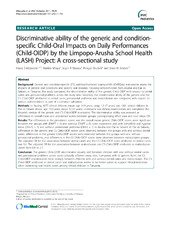| dc.contributor.author | Mbawalla, Hawa S. | en_US |
| dc.contributor.author | Mtaya, Matilda | en_US |
| dc.contributor.author | Masalu, Joyce R. | en_US |
| dc.contributor.author | Brudvik, Pongsri | en_US |
| dc.contributor.author | Åstrøm, Anne Nordrehaug | en_US |
| dc.date.accessioned | 2012-01-23T11:33:51Z | |
| dc.date.available | 2012-01-23T11:33:51Z | |
| dc.date.issued | 2011-05-26 | eng |
| dc.Published | BMC Pediatrics 2011, 11:45 | en |
| dc.identifier.issn | 1471-2431 | |
| dc.identifier.uri | https://hdl.handle.net/1956/5496 | |
| dc.description.abstract | Background: Generic and condition-specific (CS) oral-health-related quality-of-life (OHRQoL) instruments assess the impacts of general oral conditions and specific oral diseases. Focusing schoolchildren from Arusha and Dar es Salaam, in Tanzania, this study compared the discriminative ability of the generic Child OIDP with respect to dental caries and periodontal problems across the study sites. Secondly, the discriminative ability of the generic-and the CS Child OIDP attributed to dental caries, periodontal problems and malocclusion was compared with respect to various oral conditions as part of a construct validation. Methods: In Arusha, 1077 school children (mean age 14.9 years, range 12-17 years) and 1601 school children in Dar es Salaam (mean age 13.0 years, range 12-14 years) underwent oral clinical examinations and completed the Kiswahili version of the generic and CS Child-OIDP inventories. The discriminative ability was assessed as differences in overall mean and prevalence scores between groups, corresponding effect sizes and odd ratios, OR. Results: The differences in the prevalence scores and the overall mean generic Child-OIDP scores were significant between the groups with (DMFT > 0) and without (DMFT = 0) caries experience and with (simplified oral hygiene index [OHI-S] > 1) and without periodontal problems (OHI-S ≤ 1) in Arusha and Dar es Salaam. In Dar es Salaam, differences in the generic and CS Child-OIDP scores were observed between the groups with and without dental caries, differences in the generic Child-OIDP scores were observed between the groups with and without periodontal problems, and differences in the CS Child-OIDP scores were observed between malocclusion groups. The adjusted OR for the association between dental caries and the CS Child-OIDP score attributed to dental caries was 5.4. The adjusted OR for the association between malocclusion and CS Child-OIDP attributed to malocclusion varied from 8.8 to 2.5. Conclusion: The generic Child-OIDP discriminated equally well between children with and without dental caries and periodontal problems across socio-culturally different study sites. Compared with its generic form, the CS Child-OIDP discriminated most strongly between children with and without dental caries and malocclusion. The CS Child OIDP attributed to dental caries and malocclusion seems to be better suited to support clinical indicators when estimating oral health needs among school children in Tanzania. | en_US |
| dc.language.iso | eng | eng |
| dc.publisher | BioMed Central | eng |
| dc.relation.ispartof | <a href="http://hdl.handle.net/1956/6598" target="blank">Planning, implementation and evaluation of a school program to promote oral health among Tanzanian adolescents</a> | eng |
| dc.rights | Attribution CC BY | eng |
| dc.rights.uri | http://creativecommons.org/licenses/by/2.0/ | eng |
| dc.title | Discriminative ability of the generic and conditionspecific Child-Oral Impacts on Daily Performances (Child-OIDP) by the Limpopo-Arusha School Health (LASH) Project: A cross-sectional study | en_US |
| dc.type | Peer reviewed | |
| dc.type | Journal article | |
| dc.description.version | publishedVersion | en_US |
| dc.rights.holder | Copyright 2011 Mbawalla et al; licensee BioMed Central Ltd. | |
| dc.identifier.doi | https://doi.org/10.1186/1471-2431-11-45 | |
| dc.identifier.cristin | 831035 | |
| dc.subject.nsi | VDP::Medical disciplines: 700::Clinical dentistry disciplines: 830::Pediatric dentistry and dental caries prophylaxis: 834 | eng |

